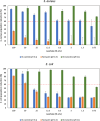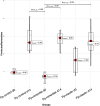Beneficial modulation of the gut microbiome by leachates of Penicillium purpurogenum in the presence of clays: A model for the preparation and efficacy of historical Lemnian Earth
- PMID: 39689103
- PMCID: PMC11651545
- DOI: 10.1371/journal.pone.0313090
Beneficial modulation of the gut microbiome by leachates of Penicillium purpurogenum in the presence of clays: A model for the preparation and efficacy of historical Lemnian Earth
Abstract
The experiments presented here are based on the reconfiguration of an ancient medicine, Lemnian Earth (LE) (terra sigillata, stamped earth, sphragis), an acclaimed therapeutic clay with a 2500-year history of use. Based on our hypothesis that LE was not a natural material but an artificially modified one involving a clay-fungus interaction, we present results from experiments involving the co-culture of a common fungus, Penicillium purpurogenum (Pp), with two separate clay slurries, smectite and kaolin, which are the principal constituents of LE. Our results show: (a) the leachate of the Pp+smectite co-culture is antibacterial in vitro, inhibiting the growth of both Gram-positive and Gram-negative bacteria; (b) in vivo, supplementation of regular mouse diet with leachates of Pp+smectite increases intestinal microbial diversity; (c) Pp+kaolin does not produce similar results; (d) untargeted metabolomics and analysis of bacterial functional pathways indicates that the Pp+smectite-induced microbiome amplifies production of short-chain fatty acids (SCFAs) and amino acid biosynthesis, known to modulate intestinal and systemic inflammation. Our results suggest that the combination of increased microbial diversity and SCFA production indicates beneficial effects on the host microbiome, thus lending support to the argument that the therapeutic properties of LE may have been based on the potential for modulating the gut microbiome. Our experiments involving reconfigured LE open the door to future research into small molecule-based sources for promoting gut health.
Copyright: © 2024 Milling et al. This is an open access article distributed under the terms of the Creative Commons Attribution License, which permits unrestricted use, distribution, and reproduction in any medium, provided the original author and source are credited.
Conflict of interest statement
The authors have declared that no competing interests exist.
Figures





Similar articles
-
The interweaving roles of mineral and microbiome in shaping the antibacterial activity of archaeological medicinal clays.J Ethnopharmacol. 2020 Oct 5;260:112894. doi: 10.1016/j.jep.2020.112894. Epub 2020 Apr 26. J Ethnopharmacol. 2020. PMID: 32348844
-
Antibacterial and therapeutic potential of historic deposits of silesian healing clay - terra sigillataSilesiaca.J Ethnopharmacol. 2025 Jan 30;337(Pt 2):118853. doi: 10.1016/j.jep.2024.118853. Epub 2024 Sep 24. J Ethnopharmacol. 2025. PMID: 39326814
-
Mitigation of colitis with NovaSil clay therapy.Dig Dis Sci. 2015 Feb;60(2):382-92. doi: 10.1007/s10620-014-3360-7. Epub 2014 Sep 21. Dig Dis Sci. 2015. PMID: 25240298
-
Dietary glycation compounds - implications for human health.Crit Rev Toxicol. 2024 Sep;54(8):485-617. doi: 10.1080/10408444.2024.2362985. Epub 2024 Aug 16. Crit Rev Toxicol. 2024. PMID: 39150724
-
Can the gastrointestinal microbiota be modulated by dietary fibre to treat obesity?Ir J Med Sci. 2018 May;187(2):393-402. doi: 10.1007/s11845-017-1686-9. Epub 2017 Oct 16. Ir J Med Sci. 2018. PMID: 29038988 Review.
References
-
- Hasluck FW. Terra Lemnia. Ann British School at Athens. 1909;16:220–31.
-
- Hasluck FW, Hasluck MM. Terra Lemnia. Christianity and Islam under the sultans. 2. Oxford: Oxford University Press; 1929. p. 671–88. https://hdl.handle.net/2027/heb00891.0002.001
-
- Brock AJ. Greek medicine: being extracts illustrative of medical writers from Hippocrates to Galen. Londo, Dent and Sons;1929.
-
- Tourptsoglou-Stefanidou V. Tαξιδιωτικá και γεωγραφικá κεíμενα για την νήσον Λήμνο (15oς-20oς αιώνας), [Geographic and travellers accounts about the island of Lemnos (15th-20th centuries)]. Thessaloniki: University of Salonika; 1986.
-
- Jaronowski H. «An Earth by any Other Name»: Pre-ottoman Sources and Names for Lemnian Earth. Hellenika. 2008;58(1):47–70.
MeSH terms
Substances
LinkOut - more resources
Full Text Sources
Molecular Biology Databases
Miscellaneous

